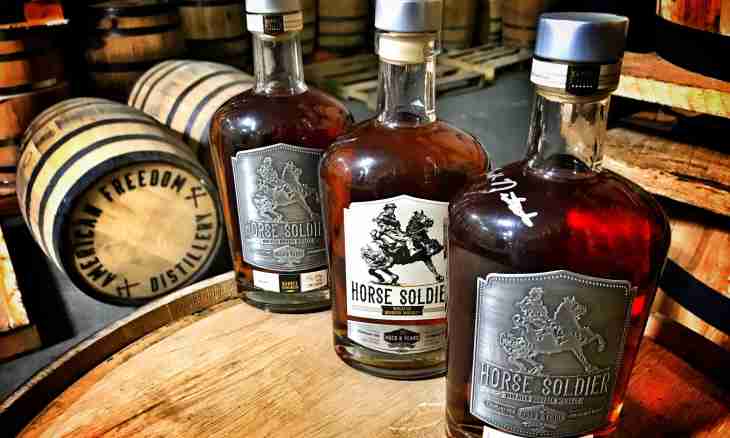The American whisky, branded drink, possesses rich history that very skillfully corresponds to its refined taste and quality. Through many wars, triumphs, the bans and revolts, whisky I made the way and yet survived.
Primary sources
The birthplace of the American whisky can be tracked to states Virginia, Maryland and Pennsylvania in the east of the USA. In 1791, whisky began to cook as a rye product. The then current president saw a promise of additional income in this enterprise and therefore sought to tax him that was met by open resistance. This fiasco became known as "a whisky revolt"". The Irish pioneers who lodged in hilly states of Tennessee and Kentucky the first began to cook the American whisky. It was possible to find in these states easily necessary raw materials and other resources — that did production of whisky by almost light business!
They came across clean waters rich with lime and a lot of wood that allowed to make barrels for transportation and storage. Corn, the main ingredient of whisky, (occupies 51% of the general share of ingredients) also was much. At this stage of the creation the American whisky saw further division of two widespread brands: sour mash and bourbon. Each of these brands, though offered various tastes and experience, cut out an own niche and had strong reputation of distinctive American drinks. The sour mash brand, remains to right roots, and still is generally made in Tennessee. It is no wonder that sour mash became pride and joy of this mountain, southern state.
The American whisky, branded drink, possesses rich history that very skillfully corresponds to its refined taste and quality. Through many wars, triumphs, the bans and revolts, whisky I made the way and yet survived.
Development
By 1870, trade of whisky became well developed across all America. The famous political figures, Thomas Jefferson, George Washington, Benjamin Franklin and even Abraham Lincoln, each of which had the license for alcohol, anyway (most often in a private order) participated in trade. At this stage the legislation was aimed at providing supervision of production of whisky, and this situation began to be applied. The legislation, however, not really strict it couldn't keep unfair dealers from transfer of the fakes packed into bottles from under whisky and are marked per se; this supervision was especially difficult as transportation between distilleries and suppliers in taverns of clients, was carried out with use of horse crews and the buggy.
It was quickly revealed that the sealed and marked bottles were the only way to guarantee that swindlers were kept in awe. George Barvin Brown began this practice, and originally he sold only to doctors and the practicing doctors. Soon enough, authoritative taverns began to brand the bottles a label. After some resistance from other traders who did ""murder"" of sale of non-standard whisky the trend became a standard commercial rule (especially when consumers rejected any products which arrived in not sealed bottles). The sealed bottles with the printing label became in the best way to earn real money on sale of whisky.
In other events of 1897 one more law guaranteeing to clients authenticity of their whisky was adopted. This law headed by the colonel Edmund Haynes Taylor - younger and the Minister of Finance John Mr. Karliz, is designed to provide observance of standards concerning sale of "direct" whisky. The law "bottled in the Bond" which means that whisky has to be direct (50% of alcohol on volume) was born and to be made for one season of distillation under one distiller and on the basis of one distillery. It also had to be stored in a federal warehouse under the supervision of the U.S. Government, at least four years. This fastened whisky still has reputation of the best of the best.
Negative reaction and rescue
Abuse of alcohol led to the high level of alcoholism among the American inhabitants that urged on policy of the ban. This law was directed to be considered as damage to social values. The era of the ban was between 1922 and 1933, and these laws forbade production of all alcohol; supporters of the ban saw the main catalyst of the troubles tested in society in alcohol. However by 1933 it became obvious that the ban will remain a noble experiment as its failures were too noticeable to deny. The American whisky, thus, endured this great call, strengthened the existence even more and again took the place in the hearts of Americans.
By 1964 Bourbon became so integral part of the American identity that the U. S. Congress recognized it as "an excellent product"; this declaration was a great honor because she used whisky to unite all Americans. Thus, precepts of law were accurately established for the quality standards of true bourbon. These standards were established as follows: at least 51% of the corn distilled up to 80% of volume of alcohol. whisky may contain only natural ingredients (i.e. no other artificial additives were allowed, except water), and bourbon had to be matured in the special barrels made only of the charry oak. Other American brands of whisky had to conform to additional standards of quality control of grain, endurance and a rasstoyka to qualify certain designations of whisky. Undoubtedly, these strict standards provided to the American whisky a possibility of the choice.
Some brands of the American whisky which passed test time include Jim Beam, Maker's Mark, Wild Turkey and Eagle Rare. Distilleries in Kentucky, Tennessee and Virginia are open for excursions and tastings to allow public to test origin of true American whisky.

